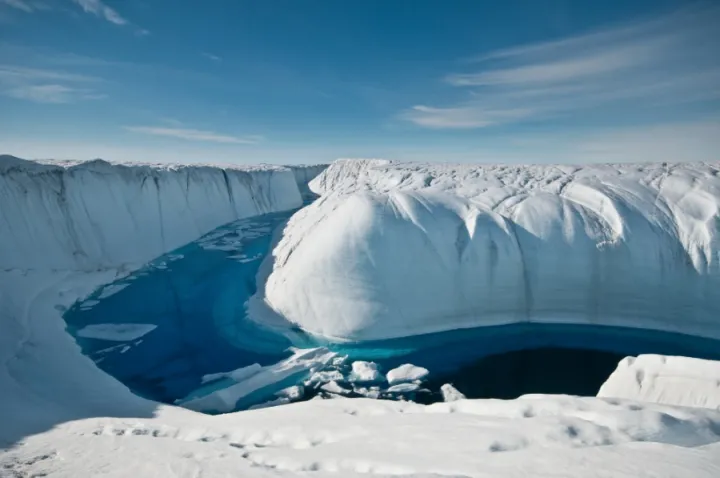The Cultural Icescapes of the Arctic

Sea ice is typically viewed as the domain of physical and natural scientists, the oceanographers, marine biologists, climate modelers, and navigators of the world. It is easy to forget another perspective—that of cultural anthropologists like myself. I have often written about how dramatic changes in the polar climate have impacted people’s cultures during centuries past, and now I am watching these changes with my own eyes. In the areas where polar people regularly venture out onto the ice, they view it as a part of their home environment and a familiar space. They use it as platform for hunting, transportation, training, and communal activities. The annual melting and refreezing of sea ice that seems so dramatic to people living in more southern climes is an established and much welcomed part of the seasonal cycle for residents of the Arctic. As that cycle is altered by global warming, the day-to-day lives and cultures of the people living on the ice will ultimately have to change along with it.
Such established ice habitats bear many typical features of land-based cultural environments. Arctic residents have developed elaborate vocabularies for many local ice forms and processes. They call the ice their ‘winter highway’ and populate it with hundreds of local place names, terms, trails, and navigation marks, along with stories and ideas. Different kinds of ice that are indistinguishable to people living outside the Arctic have their specific names, and the Inuit people of the North Alaska-Bering Strait have more than a hundred words for different types of sea ice and ice processes. For example, the Yupik hunters of Alaska's St. Lawrence Island use more than 10 different words to distinguish between different types of newly forming ice, such as qenu (slush ice) and qenughhaghaq (slush ice just as it starts to form), saagsiqu (grease ice) and allungelquq (pancake ice), aygughnin (newly formed ice built against the wind), saalqaaq (thin ice on the water surface that just started to freeze), sallegpak (new ice that was formed very quickly), sallek (ice forming at low temperature on the calm water), and sigiin (refrozen new ice in open cracks). And that's just the tip of the iceberg (so to speak); their full ice nomenclature has more than 120 terms!
The richness of what polar people know about their ‘home ice’ is staggering. Just as people in warmer climates may have intimate knowledge, memories, cultural practices, and rules of behavior surrounding their local landscapes—whether they be the houses on their block, the trees in a nearby park, or the undulations of nearby hills—Arctic indigenous people are deeply familiar with their icescapes. They have transmitted their age-old knowledge of sea ice via stories, careful training, and generations of shared experiences. This knowledge was barely touched by generations of polar explorers, oceanographers, and climate specialists, and now, as languages and traditions are weakened or lost, cultural knowledge about the ice ceases to be transmitted. The frozen sea turns back into the ‘wild ice,’ a cultural desert, an endless mass of unnamed and dangerous cracks and ridges.
These cultural icescapes aren’t just threatened by encroaching language and knowledge loss, but also by climate change. Current planetary warming is happening twice as fast in the Earth’s polar regions than at warmer, lower latitudes, and sea ice has turned out to be a very sensitive indicator of change. Climate specialists estimate that the Arctic Ocean now has 55% less ice during the summer months compared to thirty years ago in terms of the area it covers, and 75% less in terms of its volume. If this trend persists, the Arctic may have little or no ice in the summertime by the year 2030, and mostly thin, young, and very unstable ice during its much warmer winters. The melting Arctic is a harbinger of what the future may hold in other parts of the planet: sandbagged coastal communities, loss of property, relocations, and billions in infrastructural damage.
Northern indigenous people are rightly worried about the implications of the loss of their ice home and culture. But it is not just Arctic people that are affected by the warming climate. As the Arctic becomes increasingly ice-free during the summer, a new arena is emerging for conflicting perspectives on the sea ice viewed respectively as a home, a habitat for endangered species, a threat to navigation and development, a barrier against storms and erosion, a freshwater resource, and a symbol of planetary health. Biologists view sea ice is the foundation of unique marine ecosystems, with its specific regime and associated biological species. The Coast Guard, transportation, and search-and-rescue operators watch the Arctic ice mainly as an impediment to their mission. To the Arctic oil-and-gas industry, the ice is primarily a threat, whereas to tourist operators it is a business resource of spectacular scenery to lure boatloads of visitors to the North.
In this context of rapid change, local knowledge created by Arctic people is a priceless asset for future strategies for sustainable stewardship of the polar ecosystem. Arctic people gained remarkable experience in maintaining cultural and biological diversity in their home icescapes—knowledge that, if preserved for future generations, could help the humanity adapt to climate change. Indigenous knowledge demonstrates that Culture—in technologies, ideas, observations, beliefs, ethics, and specific choices—is the key human tool for the effective and long-term response to climate change. We are all together in the boat of global change, and everyone’s contribution in sustaining our planet’s health matters.
Find out more about Arctic sea ice! Get a sense of the variety of ice in this video by marine scientist Cassandra Brooks. Learn about how the loss of sea ice is affecting harp seals, and see a slideshow of photos from under the Arctic ice.



